Translate this page into:
Microsystem based Energy Harvesting (EH-MEMS): Powering pervasivity of the Internet of Things (IoT) – A review with focus on mechanical vibrations
-
Received: ,
Accepted: ,
This article was originally published by Elsevier and was migrated to Scientific Scholar after the change of Publisher.
Peer review under responsibility of King Saud University.
Abstract
The paradigm of the Internet of Things (IoT) appears to be the common denominator of all distributed sensing applications, providing connectivity, interoperability and communication of smart entities (e.g. environments, objects) within a pervasive network. The IoT demands for smart, integrated, miniaturised and low-energy wireless nodes, typically powered by non-renewable energy storage units (batteries). The latter aspect poses constraints as batteries have a limited lifetime and often their replacement is impracticable. Availability of zero-power energy-autonomous technologies, able to harvest (i.e. convert) and store part of the energy available in the surrounding environment (vibrations, thermal gradients, electromagnetic waves) into electricity to supply wireless nodes functionality, would fill a significant part of the technology gap limiting the wide diffusion of efficient and cost effective IoT applications. Given the just depicted scenario, the realisation of miniaturised Energy Harvesters (EHs) leveraging on MEMS technology (MicroElectroMechanical-Systems), i.e. EH-MEMS, seems to be a key-enabling solution able to conjugate both main driving requirements of IoT applications, namely, energy-autonomy and miniaturisation/integration.
This short review outlines the current state of the art in the field of EH-MEMS, with a specific focus on vibration EHs, i.e. converters capable to convert the mechanical energy scattered in environmental vibrations, into electric power. In particular, the issues in terms of conversion performance arising from EHs scaling down, along with the challenge to extend their operability on a frequency range of vibrations as wider as possible, are going to be discussed in the following.
Keywords
Energy Harvesting (EH)
MEMS
Internet of Things (IoE)
Ultra-Low Power (ULP)
Zero-power electronics
1 Introduction
We are living in a world where the surrounding environment and objects supporting us in daily life are seamlessly becoming more adaptive and interconnected. Services are broader, more capillary, linked together and easy to access. Experiences are tailored to our preferences and specific (as well as special) needs. The attribute ‘smart’ is now frequently associated to diverse application fields of science and technology, giving rise to familiar keywords like Smart Cities, Homes, Objects, etc.
The Internet of Things (IoT) paradigm portrays an ongoing technology development path through which any object and environment belonging to our daily life experience, earns its own identity in the digital world by means of the Internet. The IoT is based on smart objects/environments with one or more of the following functionalities (Econocom, 2016):
-
Self-awareness, i.e. identification, localisation and self-diagnosis of the object/environment;
-
Interaction with the surrounding environment, i.e. data acquisition (sensing and metering) and actuation;
-
Data elaboration, both basic (primitive data aggregation) and advanced (statistics, forecasts, etc.).
Regardless of the set of functionalities, all the smart objects/environments must feature data transfer capabilities (wired or wireless) in order to be networked and framed in the IoT. Despite the fields of application are widely diverse, it is possible to identify macro-areas for which IoT represents the common denominator, as follows: 1) Smart City/Environment; 2) Smart Home; 3) Smart Metering/Smart Grid; 4) Smart Building; 5) eHealth; 6) Smart Logistics; 7) Smart Factory; 8) Smart Asset Management; 9) Smart Agriculture; 10) Smart Car.
The IoT holds paramount potential to impact on societal and economic structure worldwide. However, its spreading in the mentioned areas will follow difference paces, defined by articulated technological and competitive factors. Thereafter, the magnitude of the IoT paradigm is giving rise to numerous projects, training actions, alliances, fora and standardisation initiatives. This scenario proves that the IoT attracts attention of the international community at research, industrial and entrepreneurial level, as it bears the potential to stimulate novel business models that will dominate the future global economy. Most probably, it is because of the perceivable economic impact of the IoT that efforts seem to be mainly directed toward high-level Information Technology (IT) based applications (i.e. Software – SW technologies). On the other hand, less focus is posed on how the progress in modern Microsystem and semiconductor integrated technologies (i.e. Hardware – HW technologies) can be blended with the IoT paradigm to sustain it on the HW infrastructural level, and to fully enable its pervasiveness and capillarity in the society of the future. A bright outlook of this vision is framed by Uckelmann et al. (2011), when stating that ‘[…] an open and accessible infrastructure for a wider adoption of the IoT is missing’. Likewise, the book indicates that a flexible and scalable infrastructure is the key requirement for sustainable and enduring IoT. The target can be reached through integration of heterogeneous technologies aiming to autonomous objects, e.g. in terms of self-powering, for which combination of Energy Harvesting (EH) and Ultra-Low Power (ULP) technologies play a key-role (Sekine, 2017; Pennisi, 2016; Kamalinejad et al., 2015). Such a vision is supported also by the IoT European Research Cluster (IERC) (Vermesan and Friess, 2014), when stating that ‘The development of energy harvesting and storage devices is instrumental to the realisation of the ubiquitous connectivity that the IoT proclaims […]’.
Being based on Wireless Sensor Networks (WSNs), IoT applications demand for smart, integrated, miniaturised and low-energy wireless nodes, typically powered by non-renewable energy storage units (batteries). The latter aspect poses constraints as batteries have a limited lifetime and often their replacement is impracticable. Availability of zero-power energy-autonomous technologies would fill a significant part of the technology gap limiting the wide diffusion of efficient and cost effective IoT applications.
Energy Harvesting (EH), also known as Energy Scavenging (ES), literally means to extract energy from the surrounding environment and convert it into electric power. The ambient scattered energy can typically be attributed to four different sources (Vullers et al., 2010):
-
Vibration/motion, both human and industrial (e.g. human pace, domestic/industrial appliances’ vibrations);
-
Thermal energy, both human and industrial (e.g. skin temperature, engine heat);
-
Ambient light, both indoor and outdoor (e.g. artificial light and sun radiation);
-
Electromagnetic (EM) and Radio Frequency (RF) (e.g. 3G-4G base stations).
The paper is arranged as follows. After the current section that introduced the topic of the IoT and of MEMS-based EH, section 2 will frame the current trends in miniaturisation of EHs. Section 3 will provide an overview of the typical power demands and available environmental energy sources in IoT reference application scenarios. Section 4 will discuss the state of the art of vibration EH-MEMS, with focus on frequency up-conversion and extension of operability on wider ranges of mechanical stimuli. Finally, section 5 will collect some conclusive considerations.
2 Trends in miniaturisation of Energy Harvesting (EH) devices
Starting from mid ‘90s, the interest of research focused on energy autonomous strategies for electronic devices. The solution reported by Kymissis et al. (1998) exploits a piezoelectric converter housed in athletic shoes, and is one of the first examples of environmental EH for powering electronic modules. Since then research took significant steps forwards, fed by the continuous decreasing trend in Integrated Circuits (ICs) power consumption, making the scenario of self-powered (wireless) devices (Roundy et al., 2004) and traditional batteries replacement possible. Next challenges for EH are miniaturisation and integration with active electronics, opening up the floor to massive exploitation of semiconductor and Microsystem technologies. Shrinking down dimensions from macro- to micro-domain brings a dowry of pros and cons. First, devices’ footprint scaling down means reducing harvested power, it looking at first sight as a limiting constraint. Nonetheless, if supply of low-power and ULP electronics is less and less demanding (as mentioned above), on the other hand, development of micro-fabrication technologies enables to enhance EHs’ conversion efficiency. Given the concurrent growing need for integrated and miniaturised wireless sensors/actuators nodes, capable of energy autonomy and multiple functionalities, as well as provided with more on-board smart capabilities, in recent years MEMS, i.e. MicroElectroMechanical-Systems (EH-MEMS), and semiconductor-based EH has been attracting significant attention in the research and scientific community (Lallart, 2012; Tan, 2011), and is now indicated as an enabling technology for the IoT paradigm.
The current state of the art is now going to be briefly summarised for the following categories of EHs: vibration/motion; thermal; ambient light; EM and RF. Moreover, some considerations around ULP electronics for power conversion, management and storage, are also developed.
2.1 Vibration/motion
The common vibration to electric power conversion methods for EH-MEMS are basically three: piezoelectric, electromagnetic and electrostatic (Kaźmierski and Beeby, 2010). It was demonstrated that piezoelectric EH-MEMS can reach output power levels in the range of 10–50 µW for typical environmental vibrations (Alamin Dow et al., 2012), or even of more than 100 µW for large accelerations (Elfrink et al., 2011). An issue to be addressed concerns sensitivity enhancement of EHs in vibration frequency ranges available in the environment, typically up to 2–4 kHz. Non-linear elastic behaviour (Hajati et al., 2011) and multi-modality (Iannacci et al., 2014) seem two promising strategies to extend the operability of MEMS vibrating EHs.
2.2 Thermal energy
Pyroelectric materials such as AlN generate electrical charges on their surfaces when undergo temperature changes. Although AlN is widely characterised against its electrical, mechanical and piezoelectric properties (Hernando et al., 2008) for actuation and sensing applications in MEMS/NEMS, i.e. NanoElectroMechanical-Systems, devices, only few publications discuss pyroelectric properties (Fuflyigin et al., 2000; Crisman et al., 2005). Successful operation of thermoelectric EHs in combination with phase change materials powered wireless nodes in aircrafts (Elefsiniotis et al., 2013).
2.3 Ambient light
Beside innovative EH-MEMS, high power densities are achievable with commercial transducers such as miniaturised Photovoltaic (PV) cells (IXYS, 2017). The advantage is the availability of manageable voltages in very limited footprints (Prabha et al., 2011). Since research in this field is rather mature, the current activities in developing zero-power HW platforms that encompass PV cells are based on the incorporation of EHs as Commercial Off The Shelf components (COTS).
2.4 EM and RF
RF-based EH consists in converting into DC power the ambient RF energy (e.g. digital TV, 3G-4G, WiFi). The main challenge is to provide ultra-compact devices able to operate with high efficiency in wide dynamic range of the illuminating RF power in a multiband and multi-polarisation environment. Recently, research on hybrid (RF plus solar) and conformal (on Polyethylene Terephthalate – PET substrate) EHs was initiated (Collado and Georgiadis, 2013). This has to be extended by hybridisation with heterogeneous EHs (RF plus piezoelectric, RF plus thermoelectric, etc.) and by coupling EH with Wireless Power Transfer (WPT) technique (Popović et al., 2013). There are essentially two types of WPT: by near-field coupling or by far-field. Low-power WPT techniques can be used as an alternative way for powering Cyber-Physical Systems (CPSs) when too low or no energy can be harvested from other sources (Takacs et al., 2013, 2014; Vigneau et al., 2014).
2.5 ULP electronics for power conversion, management and storage
Design of µ-power converters with high efficiencies and ultra-low intrinsic power consumption is of extreme interest. Some works investigated Complementary Metal Oxide Semiconductor (CMOS) technology as a viable solution for different types of sources. A µ-power converter for thermoelectric EHs was designed to consume less than 2 µW (Doms et al., 2009). Further reductions to the sub-µW range (Dallago et al., 2008; Dini et al., 2015) are significantly boosting applications of EH. Some works in literature focus on CMOS multi-source power converters for EH, as e.g. in Bandyopadhyay and Chandrakasan (2012), where heterogeneous transducers are handled with a few µW power consumption. An example of integration of microelectronic substrates, MEMS, and µ-packaging is reported in Aktakka and Najafi (2014). There is a growing interest for electronic interfaces operating in the sub-threshold region, where minimum voltage remains currently limited to a few hundreds mV (Peters et al., 2011). The harvested energy should also be efficiently stored in low-volumes and made available upon user application demands. Super-capacitor technology (Pech et al., 2010) and nanostructured electrochemical batteries hold the promise of significant improvements.
3 Power requirements and available sources in IoT application scenarios
Bearing in mind the wide application field of the IoT it is important to build at first a rather solid idea concerning the typical power densities available in reference scenarios. In addition to this feature, it is also relevant to split such typical values depending on the specific energy source, among those mentioned earlier in this work. To this purpose, effective considerations are reported by Vullers et al. (2010), and are summarised in Table 1. The typical power densities (per unit area) of IoT scenarios are arranged depending on the four main available sources, i.e. ambient light (both indoor and outdoor), vibration/motion (human and industrial environment), thermal energy (human and industrial environment) and RF. Also importantly, distinctions are made between available densities and the fraction of such power levels that can be effectively harvested.
Source
Source power
Harvested power
Ambient Light
Indoor
0.1 mW/cm2
10 μW/cm2
Outdoor
100 mW/cm2
10 mW/cm2
Vibration/Motion
Human
0.5 m at 1 Hz
1 m/s2 at 50 Hz
4 μW/cm2
Industrial
1 m at 5 Hz
10 m/s2 at 1 kHz
100 μW/cm2
Thermal Energy
Human
20 mW/cm2
30 μW/cm2
Industrial
100 mW/cm2
1–10 mW/cm2
RF
GSM Base Station
0.3 μW/cm2
0.1 μW/cm2
As clearly emerges in Table 1, ambient light provides the highest power levels to be harvested. However, the situation changes drastically when passing from outdoor to indoor environments, as the harvested power density drops from 10 mW/cm2 down to 10 μW/cm2. This makes indoor ambient light source comparable with vibration/motion and thermal energy sources in their less favourable context, i.e. human (4 μW/cm2 and 30 μW/cm2, respectively). On the other hand, if one looks at the latter two sources in industrial application scenarios, power densities that can be harvested are definitely more relevant (100 μW/cm2 and 1–10 mW/cm2, respectively). Differently, the RF source is the one scoring the lowest levels of power to be harvested (100 nW/cm2). Nonetheless, it should be kept in mind that such a figure refers to RF energy casually scattered in the surrounding environment. Much more efficient harvesting of RF/electromagnetic power can be achieved by WPT systems, as mentioned earlier in this paper.
Given these considerations around the levels of power density available to be harvested depending on the type of environmental source and context, the focus is now moved on the performance of vibration EHs vs. miniaturisation, and on the typical power demands of specific IoT applications. To this regard, Fig. 1 is reported and commented in the following.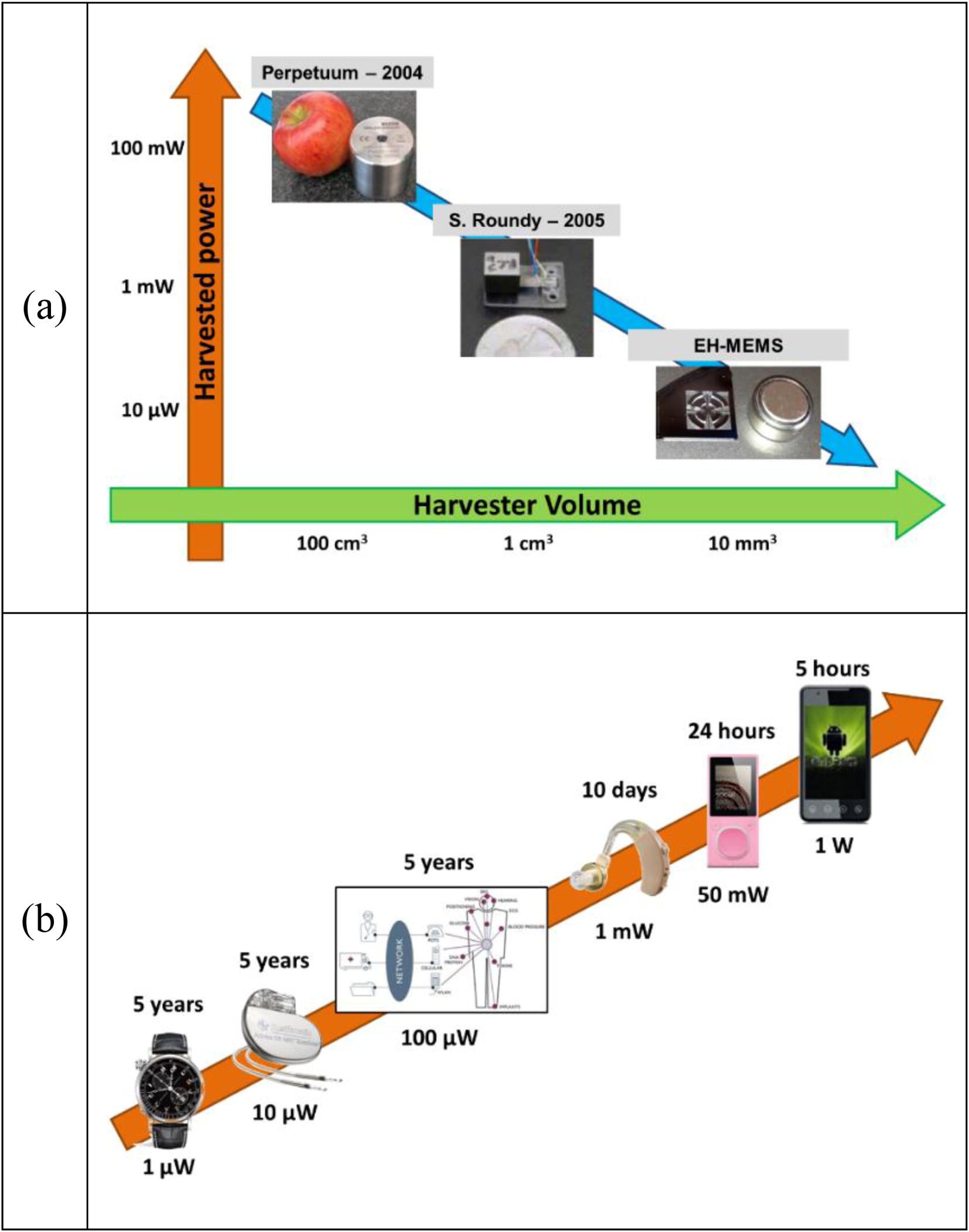
(a) Trend in miniaturisation of vibration EHs, with typical harvested power vs. EH volume for commercial macro-EHs (Perpetuum, 2013), miniaturised EHs (Roundy et al., 2004) and EH-MEMS (Iannacci et al., 2015); (b) Trend in power demands of typical IoT application scenarios (Vullers et al., 2010).
As visible in Fig. 1a, the trend in miniaturisation of vibration EHs brought to an expected shrink-down of performance in terms of harvested power. Starting from commercially available macro-EHs (Perpetuum, 2013) able to generate 100 mW, the harvester power drops to 1 mW for miniaturised EHs (Roundy et al., 2004) and, furthermore, to 10 μW when dealing with EH-MEMS solutions (Iannacci et al., 2015). However, another important aspect should be carefully evaluated: the harvester volume drops from 100 cm3 down to 10 mm3, thus opening up the floor to easy employment and integration within remote sensor node and systems.
To complete this discussion, it is now critical to compare the power levels made available by different types of vibration EHs with the power demands of typical IoT applications. To this regard, Fig. 1b provides important data to be considered (Vullers et al., 2010). The power levels required by wearable devices, like the classic wristwatch, are definitely addressable by EH-MEMS. Moreover, if considering medical devices, like pace makers, and, more importantly, distributed sensor networks for human body monitoring, like Body Area Networks (BANs), falling in the eHealth branch of the IoT, EH-MEMS are still suitable to provide the necessary operation power. On the other hand, as the power requirements increase, as it happens when dealing with portable devices, EH-MEMS are not able anymore to meet the power demands. In these cases, conventional EHs would definitely be able to meet such requirement, but the huge obstacle of integration does not make possible their employment. This means that a key-feature of EH-MEMS is the possibility to be integrated in low-power and ULP miniaturised systems, as long as the power demands are met. In conclusion, if one mistakenly thinks to power a smartphone by means of EH-MEMS, of course the exploitation of microsystem technologies leads to complete failure. However, when dealing with ULP sensing/monitoring applications, typical of the IoT, EH-MEMS are able to meet, on one side, power demands, by providing, on the other hand, the fundamental added value of small volumes and, therefore, of ease of integration. Eventually, it must also be highlighted that traditional EHs do not represent a viable option in such application contexts, despite over-dimensioned in terms of power levels.
4 State of the art of miniaturised (MEMS) vibration EHs
As mentioned before, the most common vibration to electrical power conversion methods for EH-MEMS are basically three: piezoelectric, electromagnetic and electrostatic (Kaźmierski and Beeby, 2010). In the first case, the piezoelectric effect is exploited to extract electricity from the mechanical vibration of a suspended proof-mass (Erturk and Inman, 2011). In electromagnetic scavengers, instead, the oscillation of a permanent magnet induces an electric current in a coil (Tao et al., 2012). Finally, the electrostatic transduction is based on charge displacement in two capacitor electrodes in relative movement (Liu et al., 2012). Piezoelectric conversion in the micro-domain exhibits power densities that are even larger than traditional macro devices, as reported in (Tan, 2011). Differently, electromagnetic (Cugat et al., 2003) and electrostatic micro-devices are in general less performing, despite also less mature, if compared to piezoelectric solutions (Tan, 2011), and thereby still admit considerable margins of improvement.
Another issue arising from miniaturisation of EHs is the scaling of operating frequency. As is well known, resonant frequency of a vibrating device increases when its mass and geometry are shrunk (Kaźmierski and Beeby, 2010), while most part of ambient vibration energy is available below a few kHz (e.g. busy street, car engine, industrial/domestic appliance, etc.) (Roundy et al., 2004). State of the art solutions to circumvent this problem are available, them being based on up-conversion of ambient vibration frequency until reaching the converter resonance. For instance, this is achieved by exploiting complementary magnets (Galchev et al., 2012; Fu and Yeatman, 2017). In particular, in the work of Fu and Yeatman (2017) a piezoelectric cantilevered EH with a magnet placed on the free tip, is placed above a rotating plate also provided with a magnet, as shown in the schematic in Fig. 2.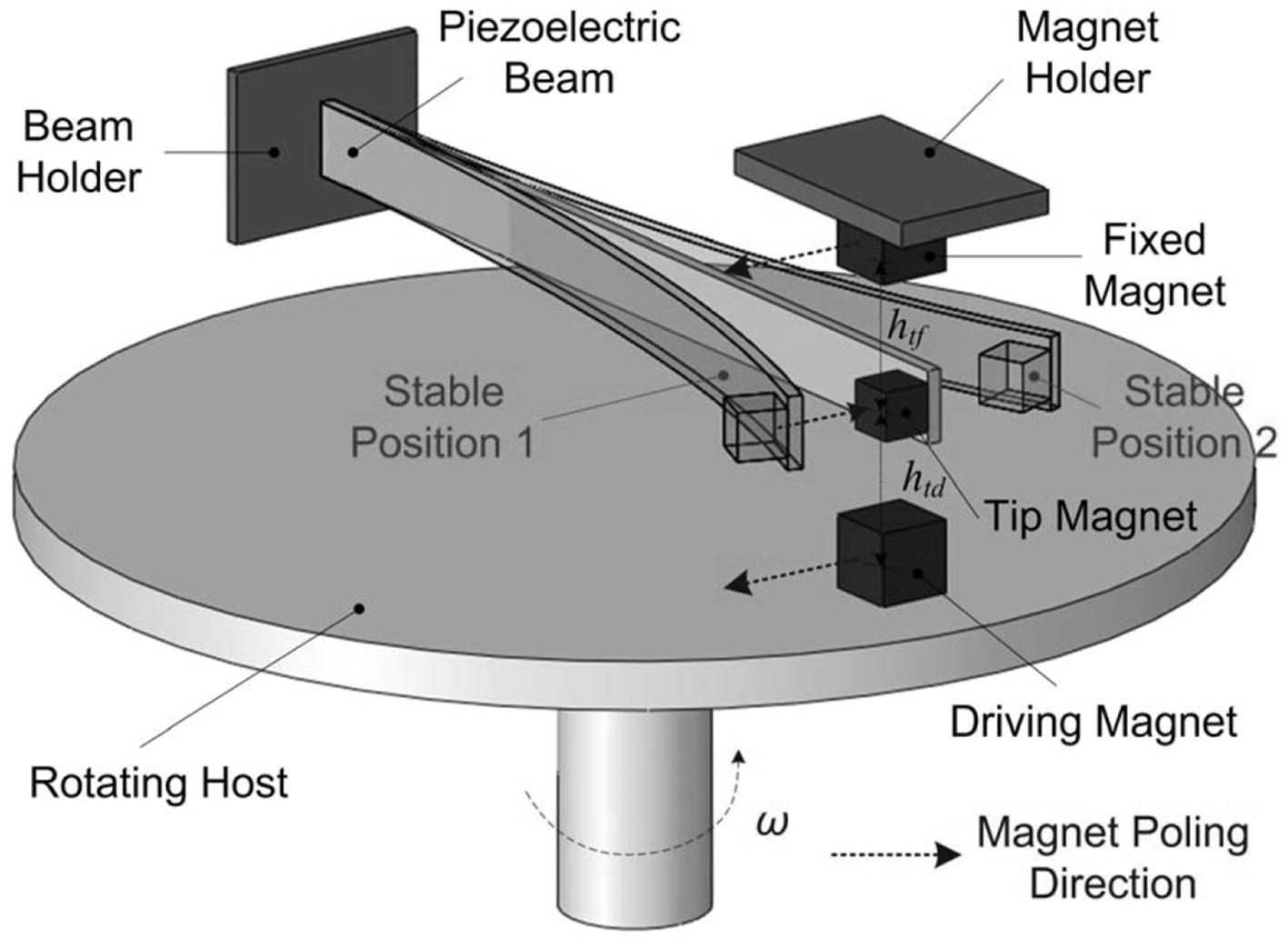
Schematic of the up-conversion frequency mechanism proposed by Fu and Yeatman (2017), able to make the cantilevered piezoelectric EH freely resonate at its characteristic frequency.
When the plate rotates (low-frequency), the magnet interacts with the one on the tip of the cantilever, and the latter one freely vibrates at its characteristic frequency (higher than plate’s rotation) thus converting mechanical into electrical energy. The EH is able to generate up to 65 μW of Root Mean Square (RMS) power, for mechanical vibrations up to 12 Hz. The cantilever is 33.5 mm long, 2 mm wide, 250 μm thick, and the converter is closed on a resistive load of 180 kΩ.
Other approaches to up-convert the frequency of vibrations are based on designing the EH mechanical structure so that snap (Fu et al., 2012; Zorlu et al., 2011) and buckling induced pulses (Chamanian et al., 2012) are imposed to the micro-converter. Additional solutions directed to widen EHs vibration spectrum of sensitivity are also discussed in literature. By making the elastic behaviour of a vibrating mass non-linear, device frequency response exhibits a chaotic behaviour (Duffing mode resonance) (Halvorsen, 2012), extending the frequency range of operability and, in turn, the level of extracted power (Hajati et al., 2011; Goldschmidtboeing et al., 2009). Hybrid solutions relying on piezoelectric/electromagnetic energy converters, also featuring frequency up-conversion by means of folded cantilevered structures, are also discussed in literature (Kwon et al., 2017) Moreover, tuning of the EH resonant frequency is also studied to maximise extraction in the widest possible range of operability (Todorov et al., 2011; Podder et al., 2017).
Concerning technology, the scientific literature is populated by findings in the field of material science and thin-film deposition techniques, resulting in relevant improvements in power conversion of vibration EHs. Starting from piezoelectric materials, the optimisation of deposition conditions (e.g. temperature, grain growth) (Akiyama et al., 2009; Zukauskaite et al., 2012) and in patterning of layers (i.e. interdigitated) (Chidambaram et al., 2012) reflects in large enhancements of piezoelectric response. Concerning electrostatic (i.e. capacitive) EHs, the conversion capabilities are importantly boosted by deposition of densely charged electrets, i.e. permanently charged/polarised dielectric layers (Hagiwara et al., 2012; Suzuki et al., 2012). Finally, miniaturised electromagnetic EHs, previously considered to be not successful because of scaling issues, started to benefit from the development of efficient techniques for patterning (Suzuki et al., 2012) and bonding (Tao et al., 2012) of thin layers with improved magnetic properties, increasing the magnet to coil coupling, and, in turn, the EHs performance.
Given this rather extensive overview of the main functional and technological solutions to improve the power conversion capabilities of miniaturised (MEMS) vibration EHs, some recent examples of harvesters’ realisation are now going to be listed.
The work reported by Lu et al. (2016) proposes an EH-MEMS, based on interdigitated fingers and electret layer, for the conversion of energy by means el electrostatic coupling. The 3D schematic of the device is reported in Fig. 3.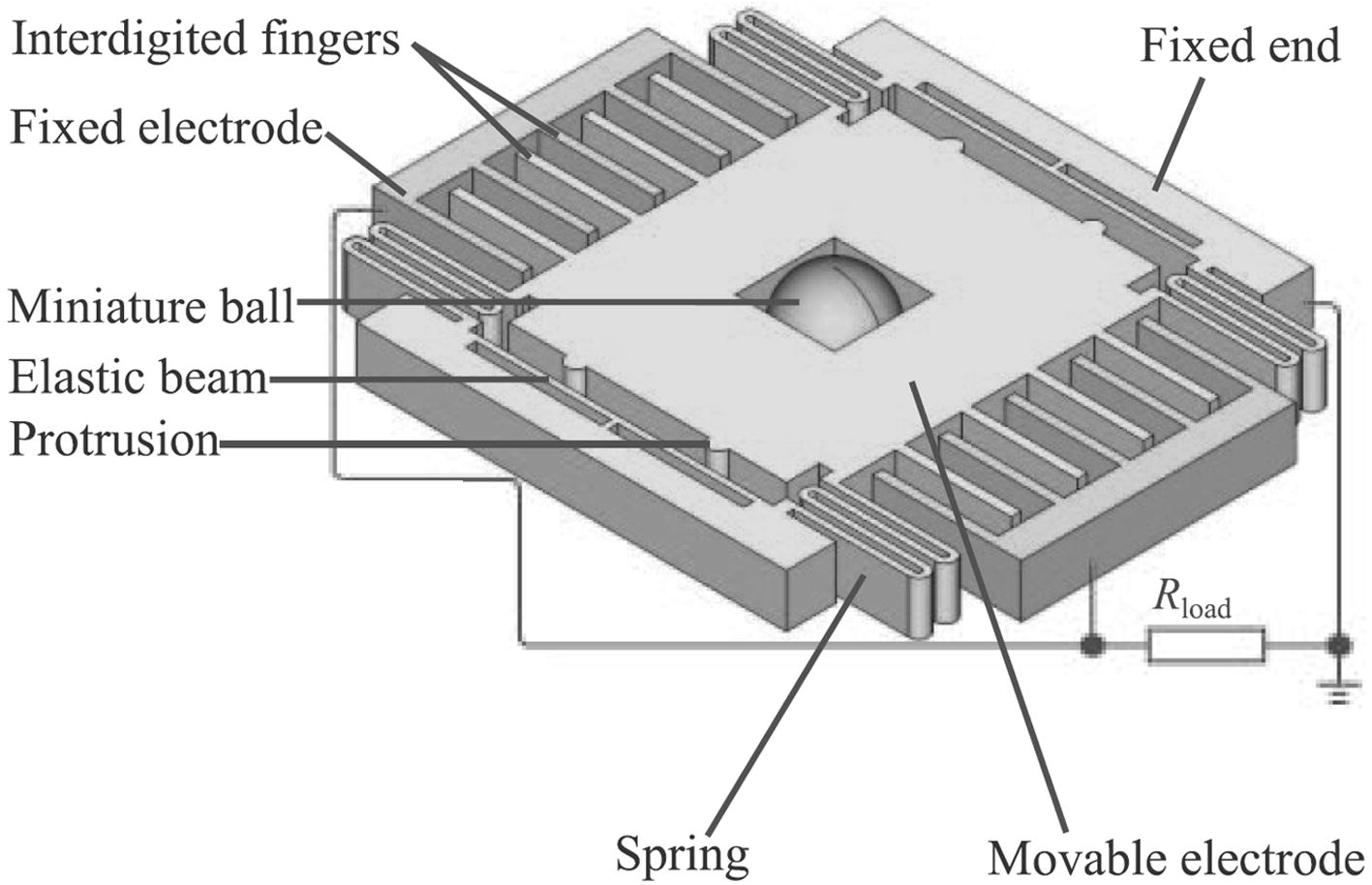
3D schematic of the electrostatic EH-MEMS concept discussed by Lu et al. (2016).
The device, whose footprint is 1 cm2, is capable to harvest more than 1 μW in the range 59-148 Hz, and more than 0.5 μW in the range 14–152 Hz, when subjected to an RMS acceleration of 2 g. A similar approach is followed by Iannacci et al. (2013). In this case, the seismic mass is anchored in its centre, by means of bow-shaped deformable suspensions. The whole device is realised in a surface micromachining technology, normally employed to manufacture RF-MEMS devices (Iannacci et al., 2016a, 2016b).
Concerning EH-MEMS devices exploiting the piezoelectric transduction effect, an example is reported by Iannacci et al. (2016c). It is based on a toggle-type mechanical resonator concept, originally exploited and investigated in the realisation of push/pull driven RF-MEMS variable capacitors (varactors) and switches (Sordo et al., 2013). The toggle-type resonator features a rectangular deformable membrane, anchored at four points, nearby the central region of the longer edges. Two seismic masses are connected along the membrane short edges. A microphotograph of a physical toggle-type piezoelectric EH-MEMS is reported in Fig. 4a. The top metallisation, implementing the surface electrode that collects charges generated at the interface with Aluminium Nitride (AlN) and the lines to redistributed electrical signals out of the resonator, are visible.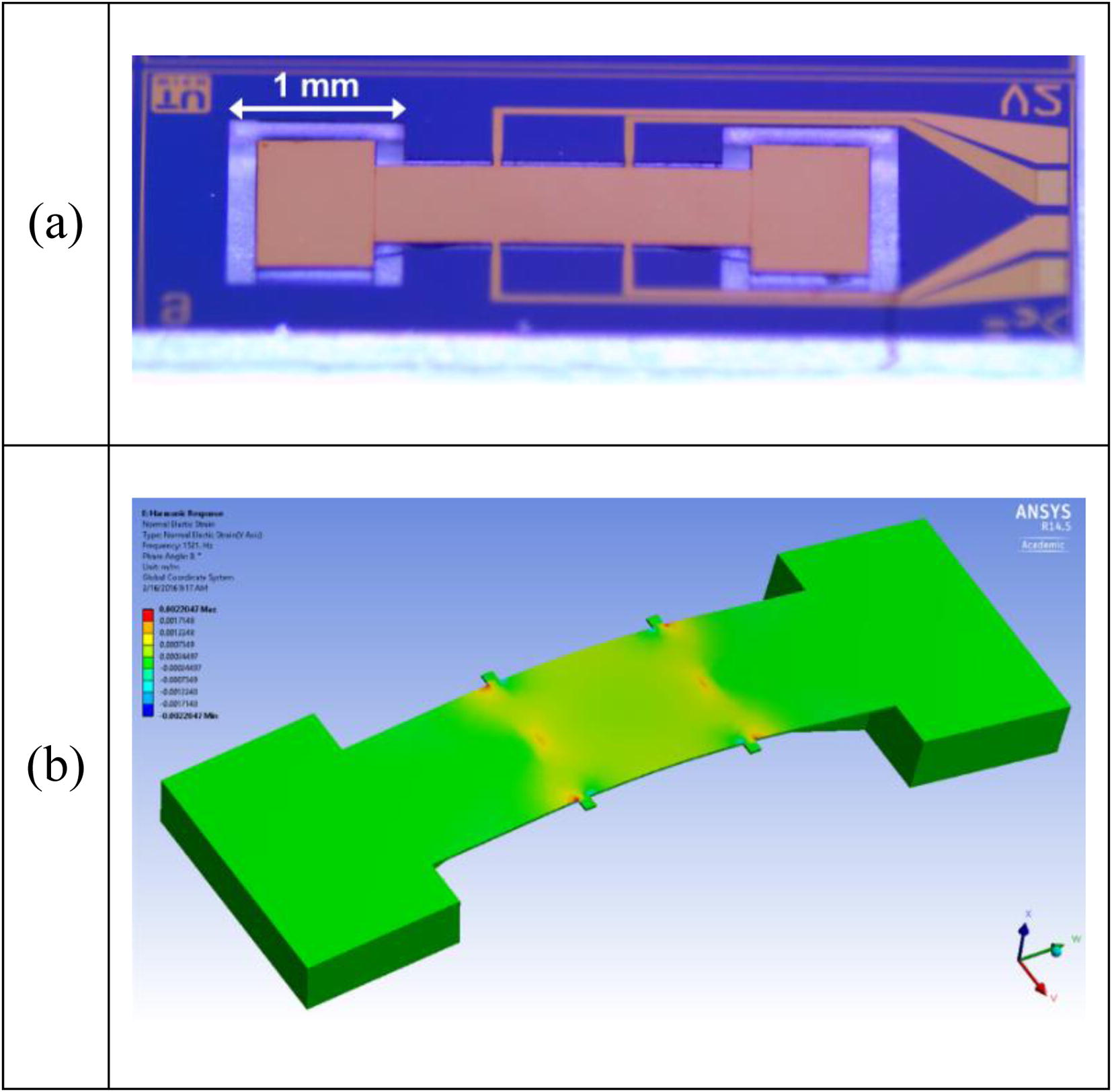
(a) Microphotograph of the toggle-type EH-MEMS discussed by Iannacci et al. (2016c); (b) Simulated 3D schematic of the toggle when the central membrane is deformed. The colour scale indicates the normal in-plane strain distribution at resonance.
The dynamic behaviour of the toggle resonator is shown in Fig. 4b, where the in-plane mechanical strain distribution is displayed (colour scale) on the surface of the 3D schematic, when simulated (via a Finite Element Method – FEM tool) at resonance. As expected, the maximum strain concentration takes place in the deformable membrane, in the vicinity of the four mechanical anchoring points, i.e. where the toggle resonator is fixed to the surrounding Silicon frame. This is the area where the mechanical into electrical energy conversion is more effective. Fig. 5 reports the experimental vs. simulated power response of the toggle-type EH-MEMS nearby resonance (about 1.52 kHz), when loaded on 1 MΩ resistor and subjected to different accelerations.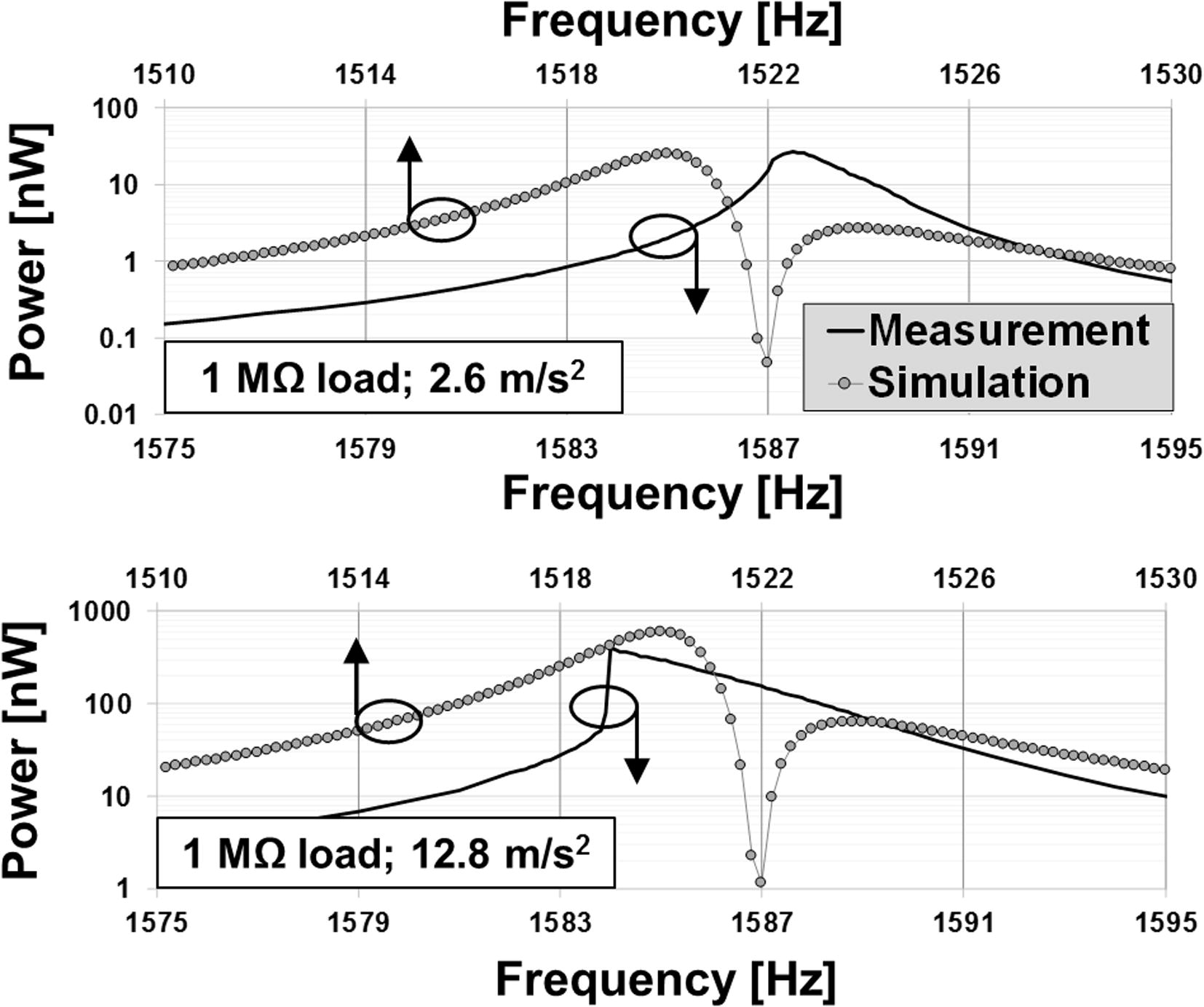
Measured vs. simulated power conversion response of the toggle EH-MEMS (Iannacci et al., 2016c) around resonance (∼1.52 kHz), when subjected to different acceleration levels.
The tested devices provided up to 396 nW RMS power at resonance (∼1.52 kHz) when stimulated with 1.3 g sinusoidal acceleration, at ambient pressure. Thanks to the reduced EH-MEMS volume of 1.94 mm3, Normalised Power Density (NPD) figures of about 240 μW/g2/cm3 are achieved.
Apart from the need of up-converting the operation frequency of EH-MEMS, already discussed before, a very crucial aspect is achieving good power conversion characteristics in a frequency range of mechanical vibrations as wide as possible. As a matter of fact, the main motivating driver lying beneath the requirement of wideband EHs, is the one of exploiting the same converters in a broad variety of application scenarios, where the frequency (and amplitude) of available environmental vibrations can significantly vary. The approaches and solutions discussed in literature to achieve operation of EHs on wider input frequency ranges are various. Essentially, the best of conversion performance is achieved when the EH is stimulated by a mechanical vibration at (or very close to) the fundamental resonant frequency. Therefore, extending the operation range of a certain EH means adding more mechanical degrees of freedom to the structure and introducing, in turn, more resonant frequencies in the reasonable vicinity of the fundamental one.
The solution proposed by Zhang et al. (2016) relies on a dual resonant structure based on out-of-plane gap closing scheme, realising an EH-MEMS based on electrostatic conversion with dimension of 13 mm by 20 mm. The mass and spring constant of each resonating structure is slightly modified with respect to the other one. Therefore, the whole structure exhibits two resonant frequencies, thus leading the EH to the encouraging converted power levels in the range of 1.06–3.24 μW, when an external acceleration of 1 g is imposed, over the frequency range from about 140 Hz to 190 Hz.
Another approach to increase the operation frequency band consists in duplicating the EH in an array-based scheme, in which each mechanical mass-spring resonator has a slightly different behaviour with respect to all the others. In other words, the overall device is an array of different EHs, each with a unique fundamental resonant frequency (Saadon and Wahab, 2015; Wang et al., 2017). In particular, the AlN piezoelectric EH proposed by Wang et al. (2017) features six cantilevers, arranged in pairs, with an anchoring rim in the middle and the free ends oriented toward peripheral directions, as shown in the 3D schematic reported in Fig. 6.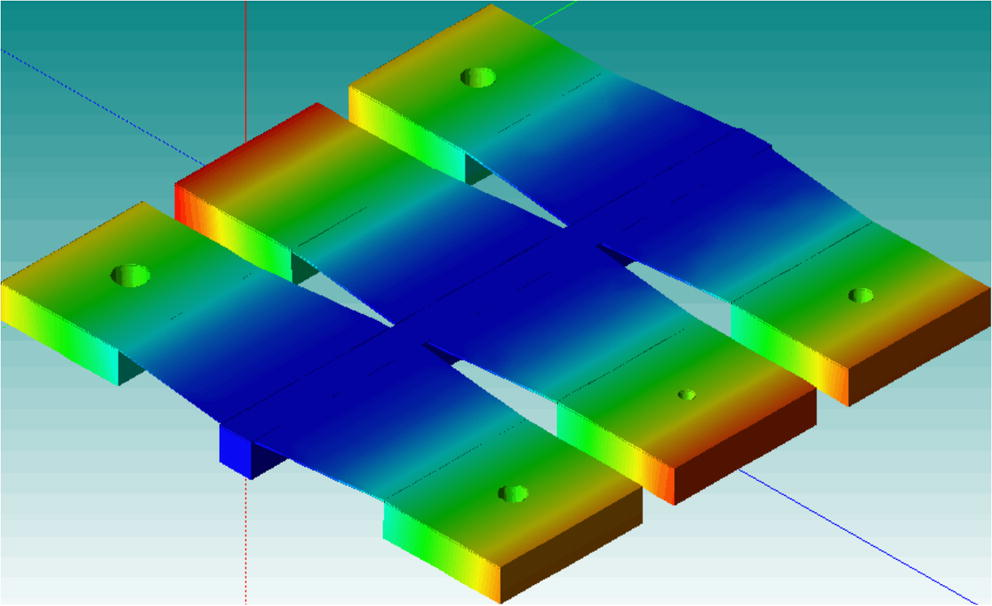
3D schematic of the array of EHs proposed by Wang et al. (2017). The holes of different diameter on 5 (out of 6) cantilevers make each of them provided with a different proof mass and, therefore, fundamental resonant frequency.
Holes of different diameter are opened on 5 (out of 6) cantilevers, in correspondence to the seismic mass at the free end. This makes each of them resonating at a different frequency, thus making the EH working in a vibration range from about 860 Hz to 925 Hz, and providing a peak-power of 82 μW (closed-loop condition) when 2 g acceleration is imposed to the device.
A different approach aimed to extend the frequency operability band of EH-MEMS is proposed by Iannacci et al. (2014, 2015, 2016d) and Iannacci and Sordo (2016). In this case, the mechanical resonator is not arrayed with variated dimension, but its geometry is made more complex to include more mechanical degrees of freedom and, in turn, to exhibit multiple resonant modes. The device, because of its particular shape, is named Four-Leaf Clover (FLC). A simulated 3D schematic of the FLC in a deformed configuration is reported in Fig. 7.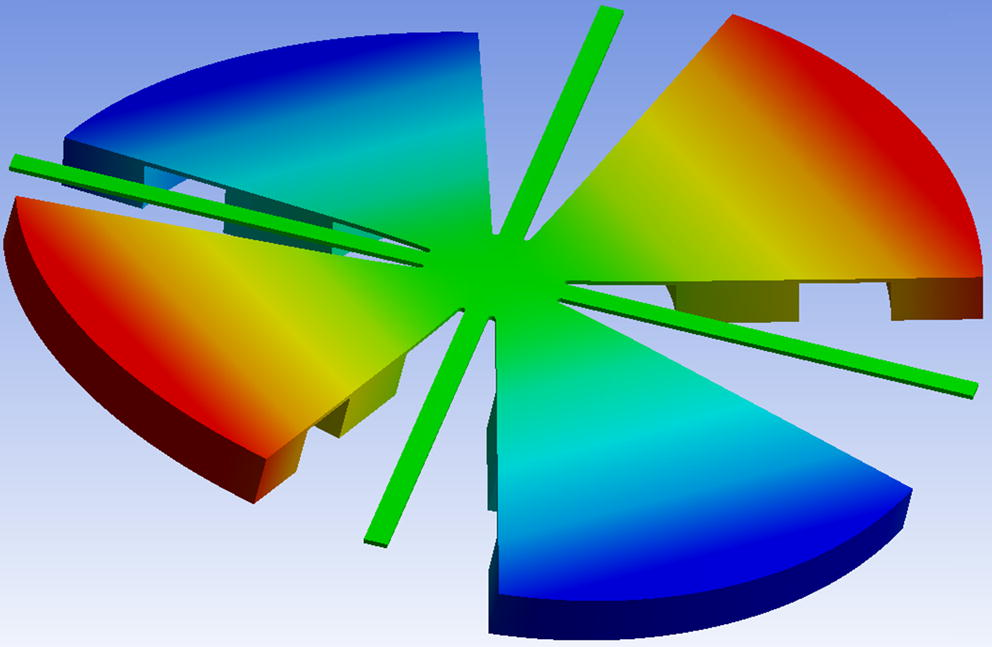
Deformed shape (colour scale) of an FLC EH-MEMS at resonance, as reported by Iannacci et al. (2014).
The FLC is composed by four petals, each of which formed by a double cascaded mass-spring system, kept suspended by four slender beams or tapered structures. The device exploits AlN piezoelectric material, deposited on the top surface, to convert mechanical into electrical energy. The FLC EH-MEMS, whose diameter is about 8 mm, exhibits several resonant modes, as observed by means of Laser Doppler Vibrometer (LDV) measurements performed on fabricated samples, and reported in Fig. 8 and Fig. 9.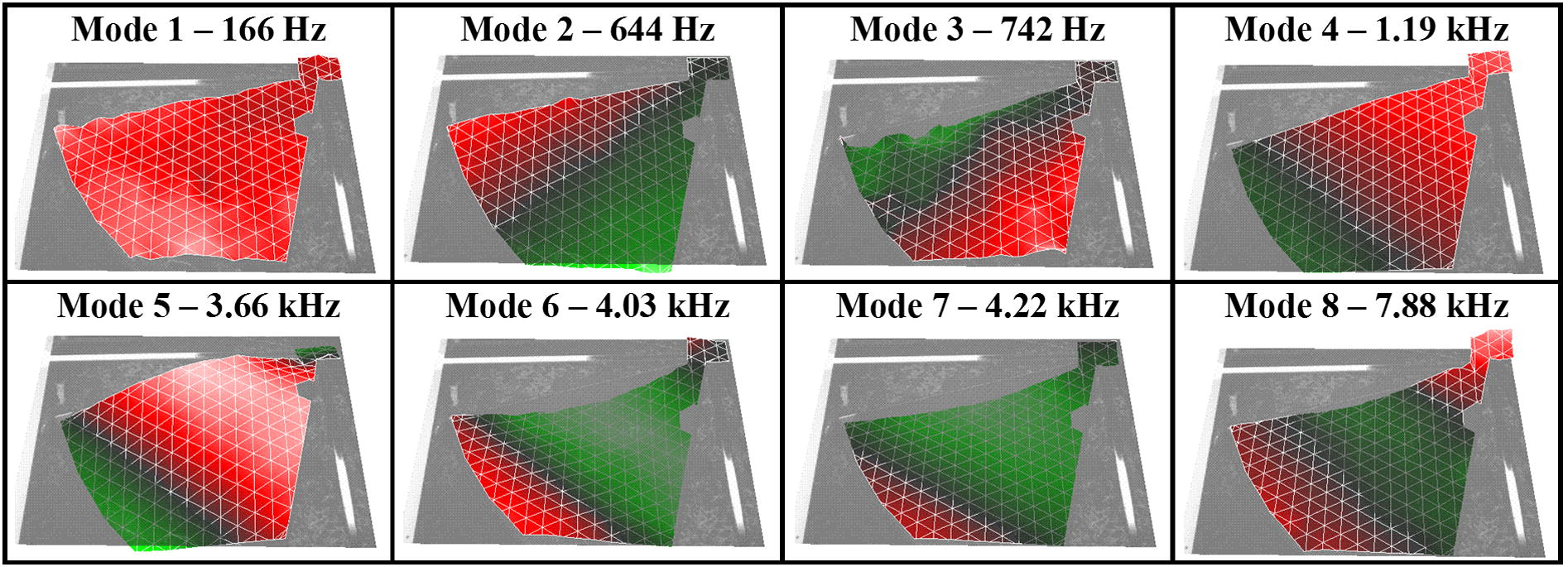
Deformation of a single petal of the FLC EH-MEMS measured with a LDV (Iannacci et al., 2015). The colour scale represents the vertical displacement.
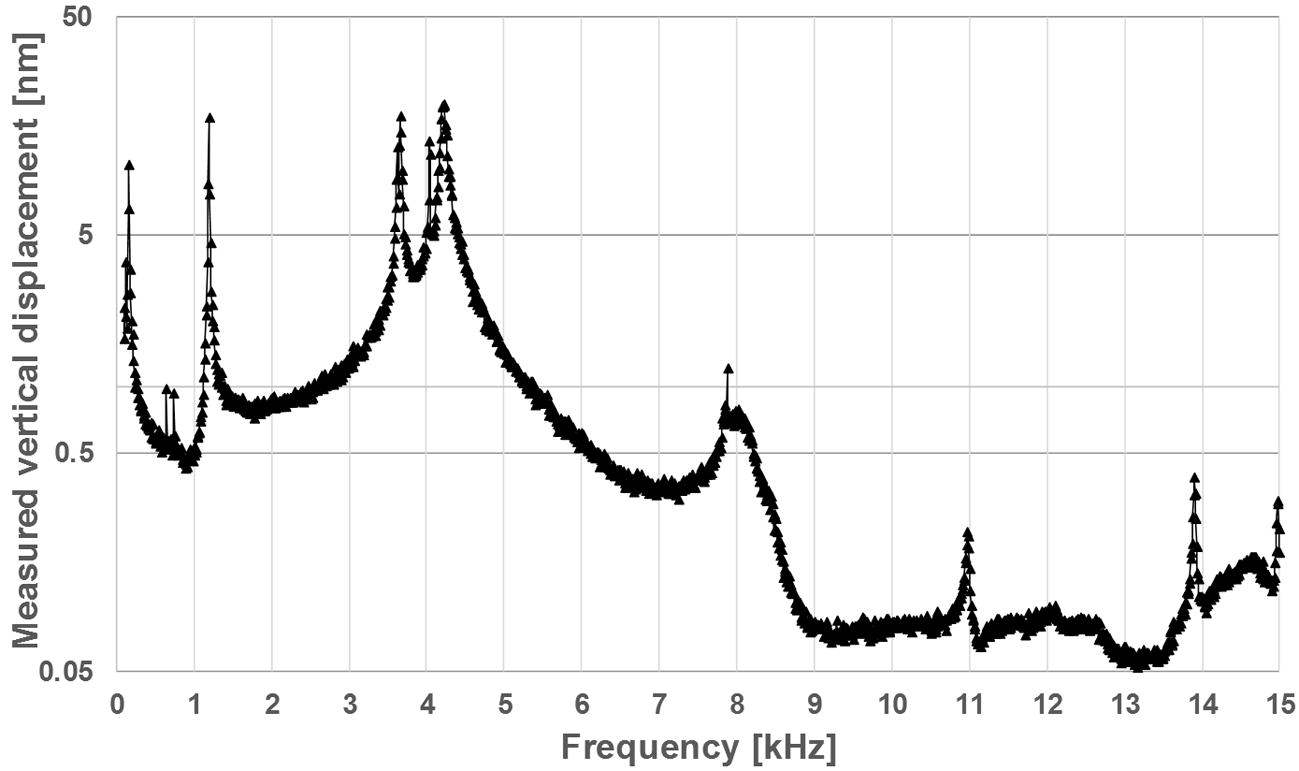
Vertical displacement of the FLC EH-MEMS stimulated with a shaking stage and measured with a LDV (Iannacci et al., 2016d). Multiple resonant modes are visible.
The FLC resonant modes start from frequencies as low as ∼200 Hz and the converted power levels are expected to be around 10 μW (Iannacci et al., 2016d).
To conclude this section, an additional solution at device level is proposed by Liu et al. (2014), with reference to an electromagnetic miniaturised EH. The device works in the frequency range from 82 Hz to 146 Hz, with power densities as high as 5.6 × 10−8 W/cm3. Additional examples of electromagnetic EH-MEMS are discussed in details by Tan et al. (2017).
5 Conclusions
Nowadays, the paradigm of the Internet of Things (IoT) is identified as the common denominator of all modern and future ‘smart’ applications that leverage on distributed and remote sensing functionalities. Nonetheless, the pronounced pervasivity demanded from IoT applications poses articulated challenges at hardware level, where the aspects of energy demand and availability are among the most critical to be handled. Development of zero-power energy-autonomous technologies, able to harvest (i.e. convert) and store part of the energy scattered in the surrounding environment (vibrations, thermal gradients, electromagnetic waves) into electricity to supply wireless nodes functionality, would fill a significant part of the technology gap limiting the wide diffusion of efficient and cost effective IoT applications. Given this scenario, the realisation of miniaturised Energy Harvesters (EHs) leveraging on MEMS (MicroElectroMechanical-Systems) technology, i.e. EH-MEMS, seems to be a key-enabling solution able to conjugate both main driving requirements of IoT applications, namely, energy-autonomy and miniaturisation/integration.
This short review outlined the current state of the art in the field of EH-MEMS, with a specific focus on vibration EHs, i.e. devices capable to convert the mechanical energy scattered in environmental vibrations, into electric power. In particular, the issues in terms of conversion performance arising from EHs scaling down, along with the challenge to extend their operability across a frequency range of vibrations as wider as possible, were addressed and discussed.
References
- Influence of growth temperature and scandium concentration on piezoelectric response of scandium aluminum nitride alloy thin films. Appl. Phys. Lett.. 2009;95:1-3.
- [Google Scholar]
- A micro inertial energy harvesting platform with self-supplied power management circuit for autonomous wireless sensor nodes. IEEE J. Solid-State Circuits. 2014;49:2017-2029.
- [Google Scholar]
- Modeling the performance of a micromachined piezoelectric energy harvester. Springer Microsystem Technologies. 2012;18:1035-1043.
- [Google Scholar]
- Platform architecture for solar, thermal, and vibration energy combining with MPPT and single inductor. IEEE J. Solid-State Circuits. 2012;47:2199-2215.
- [Google Scholar]
- Wideband capacitive energy harvester based on mechanical frequency-up conversion. Brescia: Proc. of IEEE Sensors Applications Symposium SAS; 2012. p. :1-4.
- Comparison of lead zirconate titanate (PZT) thin films for MEMS energy harvester with interdigitated and parallel plate electrodes. Aveiro: Proc. of ISAF/ECAPD/PFM; 2012. p. :1-4.
- Conformal hybrid solar and electromagnetic (EM) energy harvesting rectenna. IEEE Trans. Circuits Syst.. 2013;60:2225-2234.
- [Google Scholar]
- Large pyroelectric response from reactively sputtered aluminum nitride thin films. Electrochem. Solid-State Lett.. 2005;8:H31-H32.
- [Google Scholar]
- Magnetic micro-actuators and systems (MAGMAS) IEEE Transaction on Magnetics. 2003;39:3607-3612.
- [Google Scholar]
- Electronic interface for Piezoelectric Energy Scavenging System. Edinburgh: Proc. of ESSCIRC; 2008. p. :402-405.
- A nano-current power management IC for multiple heterogeneous energy harvesting sources. IEEE Transaction on Power Electronics. 2015;30:5665-5680.
- [Google Scholar]
- Capacitive power management circuit for micropower thermoelectric generators with a 1.4 µA controller. IEEE J. Solid-State Circuits. 2009;44:2824-2833.
- [Google Scholar]
- Econocom, 2016. How the Internet of Things is revolutionising business models. https://blog.econocom.com/en/blog/how-the-internet-of-things-is-revolutionising-business-models/ (accessed 28.03.17).
- Investigation on the performance of thermoelectric energy harvesters under real flight conditions. Springer Journal of Electronic Materials. 2013;42:2301-2305.
- [Google Scholar]
- Shock induced energy harvesting with a MEMS harvester for automotive applications. Washington: Proc. of IEEE IEDM; 2011. p. :1-4.
- Piezoelectric Energy Harvesting (first ed.). Hoboken: John Wiley & Sons; 2011.
- Fu H., Yeatman, E.M., 2017. Broadband rotational energy harvesting using bistable mechanism and frequency up-conversion. Proc. Of IEEE 30th International Conference on Micro Electro Mechanical Systems (MEMS), Las Vegas, 853–856.
- Multi-axis AlN-on-Silicon vibration energy harvester with integrated frequency-upconverting transducers. Paris: Proc. of IEEE MEMS; 2012. p. :1269-1272.
- A piezoelectric parametric frequency increased generator for harvesting low-frequency vibrations. IEEE JMEMS. 2012;21:1311-1320.
- [Google Scholar]
- Nonlinear effects in piezoelectric vibration harvesters with high coupling factors. Washington: Proc. of PowerMEMS; 2009. p. :364-367.
- Electret charging method based on soft X-ray photoionization for MEMS transducers. IEEE Trans. Dielectrics Elect. Insulat.. 2012;19:1291-1298.
- [Google Scholar]
- Design and fabrication of a nonlinear resonator for ultra wide-bandwidth energy harvesting applications. Cancun: Proc. of IEEE MEMS; 2011. p. :1301-1304.
- Fundamental issues in nonlinear wide-band vibration energy harvesting. Nonlinear Sciences, Adaptation and Self-Organizing Systems; 2012. p. :5.
- Simulation and laser vibrometry characterisation of piezoelectric AlN thin films. J. Appl. Phys.. 2008;104:053502.
- [Google Scholar]
- Up-scaled macro-device implementation of a MEMS wideband vibration piezoelectric energy harvester design concept. Springer Microsystem Technologies. 2016;22:1639-1651.
- [Google Scholar]
- Iannacci, J., Sordo, G., Gottardi, M., Kuenzig, T., Schrag, G., Wachutka, G., 2013. An Energy Harvester concept for electrostatic conversion manufactured in MEMS surface micromachining technology. Proc. of International Semiconductor Conference Dresden – Grenoble (ISCDG), Dresden, 1–4.
- Multi-modal vibration based MEMS energy harvesters for ultra-low power wireless functional nodes. Springer Microsystem Technologies. 2014;20:627-640.
- [Google Scholar]
- A novel MEMS-based piezoelectric multi-modal vibration energy harvester concept to power autonomous remote sensing nodes for Internet of Things (IoT) applications. Busan: Proc. of IEEE SENSORS; 2015. p. :1-4.
- RF-MEMS technology for 5G: series and shunt attenuator modules demonstrated up to 110 GHz. IEEE Electron Device Lett.. 2016;37:1336-1339.
- [Google Scholar]
- RF-MEMS Technology for Future Mobile and High-Frequency Applications: Reconfigurable 8-Bit Power Attenuator Tested up to 110 GHz. IEEE Electron Device Lett.. 2016;37:1646-1649.
- [Google Scholar]
- A novel toggle-type MEMS vibration energy harvester for Internet of Things applications. Orlando: Proc. of IEEE SENSORS; 2016. p. :1-3.
- The MEMS four-leaf clover wideband vibration energy harvesting device: design concept and experimental verification. Springer Microsystem Technologies. 2016;22:1865-1881.
- [Google Scholar]
- Wireless energy harvesting for the Internet of Things. IEEE Commun. Mag.. 2015;53:102-108.
- [Google Scholar]
- Kaźmierski T.J., Beeby S., eds. Energy Harvesting Systems: Principles, Modeling and Applications (first ed.). Berlin: Springer; 2010.
- Kwon, D.S., Ko, H.J., Kim, J., 2017. Piezoelectric and electromagnetic hybrid energy harvester using two cantilevers for frequency up-conversion. In: Proc. of IEEE 30th International Conference on Micro Electro Mechanical Systems (MEMS), Las Vegas, pp. 49–52.
- Parasitic power harvesting in shoes. Pittsburgh: Proc. of Second International Symposium on Wearable Computers; 1998. p. :132-139.
- Lallart M., ed. Small-Scale Energy Harvesting (first ed.). Rijeka: InTech; 2012.
- Sandwich structured electrostatic/electrets parallel-plate power generator for low acceleration and low frequency vibration energy harvesting. Paris: Proc. of IEEE MEMS; 2012. p. :1277-1280.
- An In-Plane Approximated Nonlinear MEMS Electromagnetic Energy Harvester. IEEE J. Microelectromech. Syst.. 2014;23:740-749.
- [Google Scholar]
- Lu, Y., Cottone, F., Boisseau, S., Marty, F., Galayko, D., Basset, P., 2016. Low-frequency and ultra-wideband MEMS electrostatic vibration energy harvester powering an autonomous wireless temperature sensor node. In: Proc. of IEEE 29th International Conference on Micro Electro Mechanical Systems (MEMS), Shanghai, pp. 33–36.
- Ultrahigh-power micrometre-sized supercapacitors based on onion-like carbon. Nat. Nanotechnol.. 2010;5:651-654.
- [Google Scholar]
- Pennisi, T., 2016. Energy Harvesting Powering IoT Applications With Energy Harvesting. http://www.sensorsmag.com/energy-harvesting/powering-iot-applications-energy-harvesting-23469 (accessed 28.03.17).
- A sub-500 mV highly efficient active rectifier for energy harvesting applications. IEEE Trans. Circuits Syst.. 2011;58:1542-1550.
- [Google Scholar]
- Magnetic Tuning of Nonlinear MEMS Electromagnetic Vibration Energy Harvester. IEEE J. Microelectromech. Syst. 2017:1-11.
- [Google Scholar]
- Low-power far-field wireless powering for wireless sensors. Proc. IEEE. 2013;101:1397-1407.
- [Google Scholar]
- Harvesting circuits for miniaturised photovoltaic cells. Rio de Janeiro: Proc. of IEEE ISCAS; 2011. p. :309-312.
- Energy Scavenging for Wireless Sensor Networks: With Special Focus on Vibrations (first ed.). Dordrecht: Kluwer Academic Publishers; 2004.
- Saadon, S., Wahab, Y., 2015. From ambient vibrations to green energy source: MEMS piezoelectric energy harvester for low frequency application. In: Proc. of IEEE Student Symposium in Biomedical Engineering & Sciences (ISSBES), Shah Alam, pp. 59–63.
- Sekine, K., 2017. Energy-harvesting devices replace batteries in IoT sensors. http://core.spansion.com/article/energy-harvesting-devices-replace-batteries-in-iot-sensors/#.WNpdFqIlFaQ (accessed 28.03.17).
- Sordo, G., Iannacci, J., Solazzi, F., 2013. An analytical model for the optimization of toggle-based RF-MEMS varactors tuning range. In: Proc. of International Semiconductor Conference CAS 2013, Sinaia, pp. 263–266.
- Electromagnetic energy harvester by using buried NdFeB. Paris: Proc. of IEEE MEMS; 2012. p. :1221-1224.
- Miniaturisation of quadrifilar helical antenna: impact on efficiency and phase centre position. IET Microwaves Antennas Propag.. 2013;7:202-207.
- [Google Scholar]
- Microwave power harvesting for satellite health monitoring. IEEE Trans. Microw. Theory Tech.. 2014;62:1090-1098.
- [Google Scholar]
- Tan Y.K., ed. Sustainable Energy Harvesting Technologies – Past, Present and Future (first ed.). Rijeka: InTech; 2011.
- Review of MEMS electromagnetic vibration energy harvester. IEEE J. Microelectromech. Syst.. 2017;26:1-16.
- [Google Scholar]
- Fully integrated micro electromagnetic vibration energy harvesters with micro-patterning of bonded magnets. Paris: Proc. of IEEE MEMS; 2012. p. :1237-1240.
- Tuning techniques for kinetic MEMS energy harvesters. Amsterdam: Proc. of IEEE INTELEC; 2011. p. :1-6.
- Uckelmann D., Harrison M., Michahelles F., eds. Architecting the Internet of Things (first ed.). Berlin: Springer; 2011.
- Vermesan O., Friess P., eds. Internet of Things Applications – From Research and Innovation to Market Deployment (first ed.). Aalborg: River Publishers; 2014.
- Vigneau, G., Cheikh, M., Benbouhout, R., Bouguern, S., Takacs, A., 2014. Power source evaluation of a wireless power transfer system. In: Proc. Of IEEE Wireless Power Transfer Conference, Jeju, pp. 9–12.
- Vullers, R.J.M., Schaijk, R., Visser, H.J., Penders, J., Hoof, C.V., 2010. Energy Harvesting for Autonomous Wireless Sensor Networks. IEEE Solid-State Circuits Magazine 2, 29–38.
- Wang, N., Sun, C., Siow, L.Y., Ji, H., Chang, P., Zhang, Q., Gu, Y., 2017. AlN wideband energy harvesters with wafer-level vacuum packaging utilizing three-wafer bonding. Proc. of IEEE 30th International Conference on Micro Electro Mechanical Systems (MEMS), Las Vegas, 841–844.
- Wideband MEMS electrostatic energy harvester with dual resonant structure. Orlando: Proc. of IEEE SENSORS; 2016. p. :1-3.
- A vibration-based electromagnetic energy harvester using mechanical frequency up-conversion method. IEEE Sens. J.. 2011;11:481-488.
- [Google Scholar]
- Microstructure and dielectric properties of piezoelectric magnetron sputtered w ScxAl1 xN thin films. J. Appl. Phys.. 2012;111:1-7.
- [Google Scholar]







